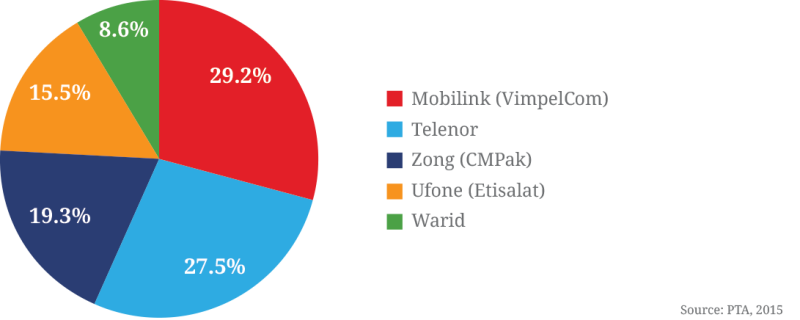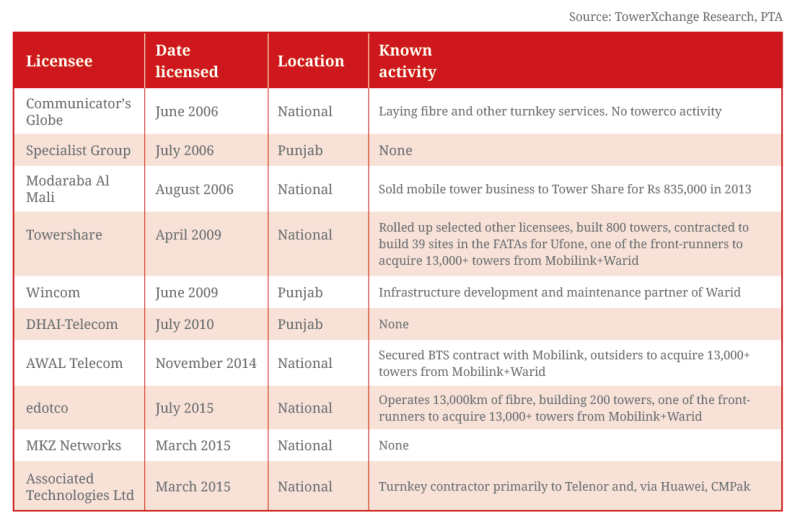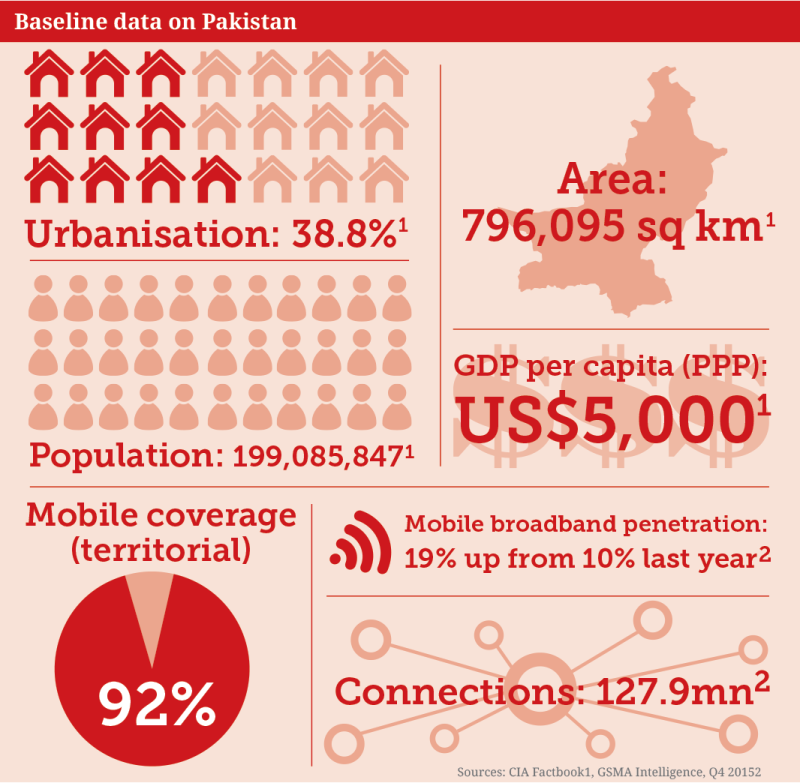The acquisition and integration of Warid by Mobilink is set to be accompanied by the spinning off of the combined operator’s towers. TowerXchange understands that one tower company has secured a period of exclusive negotiations to close the deal to acquire 13,000-13,700 towers (after the elimination of overlapping sites). A further 8,318 towers are coming to market as Ufone seeks to monetise their assets, which could increase the total level of decommissioning to around 10%. Besides parallel infrastructure, what other challenges will be faced by the towerco acquiring these assets?
The merger between Mobilink and Warid will put some competitive distance between VimpelCom’s Pakistani subsidiary and their nearest challenges Telenor. Fierce competition has driven ARPUs in Pakistan below US$2, putting pressure on the country’s MNOs to create efficiencies through infrastructure sharing. The sale of Mobilink and Warid’s combined tower portfolio is imminent, with Ufone’s towers also on the market.
How many towers are there in Pakistan, who owns them now, and what is for sale?
While the PTA suggest there were 40,704 cell sites between Pakistan’s then five MNOs in 2015, it is not clear whether shared sites are counted twice. TowerXchange has also learned that there are at least 800 independently owned towers in Pakistan, owned by Towershare.
As the first MNO in the market, Mobilink has Pakistan’s oldest and largest tower portfolio. All our sources agreed that Mobilink has almost exactly 10,000 sites, which sounds like a plausible increase in the six months since the last PTA annual report.
In 2005 when Telenor and Ufone entered the market, followed later by Zong, the new entrants lobbied for mandatory infrastructure sharing, but the market leaders were opposed as Mobilink considered their towers a competitive differentiator. During this period there were only limited scope barter agreements between MNOs.
Mobilink’s position changed in 2011-12 as they came to see the potential cost efficiencies and QoS improvement benefits of infrastructure sharing. Mobilink now leases out their towers on a commercial basis, and has around 2,500 co-locating tenants, representing a tenancy ratio of 1.25. Mobilink’s internal towerco contributes around 3% of the MNO’s total revenue (and doubtless a much higher proportion of the profit!)
It is therefore perhaps unsurprising that Mobilink’s towers are expected to fetch a significant valuation when they are sold, probably before the year end. With Mobilink’s merger with Warid now approved, both tower portfolios will be sold together: post decommissioning of ~5-8% overlapping sites, the integrated Mobilink and Warid tower portfolio is expected to consist of around 13,000-13,700 micro and macro towers. Mobilink are thought to value the portfolio at a little under US$1bn, suggesting a cost per tower of US$73-76,900, which would be consistent with the valuation comp provided by American Tower’s recent acquisition of Viom Networks in India.
Mobile subscriber market share

Mobilink’s parent VimpelCom has initiated a global tower monetisation programme, and has reportedly entered into exclusive negotiations with a preferred bidder from a shortlist believed to have included Axiata’s pan-Asian towerco edotco, which operates 13,000km of fibre in Pakistan; Dubai headquartered Towershare, which had already built or rolled up some 800 towers in Pakistan; local towerco AWAL Telecom, which recently secured a build-to-suit contract with Mobilink; and Tower Bersama from Indonesia.
Ufone are believed to have also commenced a process to monetise their 8,318 towers. Ufone is the struggling mobile subsidiary of PTC (Pakistan Telemmunications Company), whose profit after tax plummeted 52.9% between FY14 and FY15. Ufone became part of Etisalat when PTC was privatised in 2006.
Prior to the imminent sale and leasebacks, which may establish a new pricing benchmark, lease rates in Pakistan were believed to be around the US$800-1,000 per month mark.
Non-traditional MNOs may represent more than the usual level of potential upside in Pakistan, exemplified by Wi-Fi Broadband service BurQ, which plans 2,500 tenancies over the next three to four years.
Breakdown of MNO sites counts in Pakistan

The 4G spectrum auction and 4G rollout plans of Pakistan’s MNOs
Pakistan’s MNOs spent nearly US$1.2bn acquiring 3G and 4G spectrum in 2014. A further 850MHz spectrum was recently sold to Telenor Pakistan, which was the sole bidder, paying US$395mn.
3G was only launched in late 2014, but GSMA Intelligence reveals that mobile broadband penetration almost doubled year on year to 19% by Q415. Warid launched 4G in January 2015, with Zong launching in September 2015, and aiming to rollout over 5,000 4G sites by year end 2016. Telenor only launched 4G in August 2016, but it is not atypical of Telenor to be a “fast follower” rather than a first mover in new technologies.
The overlay of 4G creates an obvious opportunity for Pakistani towercos to drive tenancy ratio growth, with network planners anticipating significant densification. The merger of Mobilink and Warid creates a similar impetus: “Mobilink will have a clear spectrum advantage on all bands,” said a network planner at a competitive MNO. “We can only mitigate this through M&A or deep network sharing.”
Infrastructure sharing and parallel infrastructure in Pakistan
While you wouldn’t suggest Pakistan has a mature, deeply embedded culture of infrastructure sharing, there are believed to be over 4,000 third party tenants on the country’s towers. For example, Telenor has over 1,500 tenancies on third party sites in their Pakistani network. One network planner told TowerXchange: “100% of our future rollout will probably be on shared networks – either shared bi-laterally, or leveraging towerco towers.”
However, new entrant Wi-Fi broadband operators report experiencing slow and bureaucratic processes to co-locate on MNOs towers, and have renewed calls on the Pakistani regulator to mandate infrastructure sharing.
There is significant parallel infrastructure in Pakistan – it is not usual to see four or even five towers and rooftop structures all clustered together within 20-50m in urban areas, and there is significant network overlap in rural areas as well.
The sale of the combined Mobilink and Warid towers could lead to the decommissioning of 5-8% of towers. If the Ufone towers were acquired and pooled by the same towerco, the proportion could rise above 10%.
Network planners suggest around 20,000 sites are required to have full economic coverage in Pakistan.
Pakistan is in the early stages of fiberisation. While edotco has 13,000km of readily shareable fibre, most Pakistani MNOs are rolling out their own fibre. To date only Telenor and Zong have signed a fibre sharing agreement.
Telenor and Zong have also undertaken Pakistan’s first RANsharing trials, across approximately 30 sites, using the MORAN model (Multi Operator RAN), where there is no spectrum sharing.
While Mobilink and Warid are not currently prioritising RANsharing, the governance of RANsharing will be an important negotiating point in their tower sale.
Tower licensees in Pakistan

A progressive regulatory environment, yet local permitting and taxation challenges remain
The Pakistan Telecommunications Authority (PTA) is renowned to be a progressive regulator, exemplified by their granting permission for RANsharing trials before policy governing the practice had been drafted. The PTA was also quick to recognise the potential value independent tower companies could bring ICT in the country, licensing domestic towercos as long ago as 2006 – although only two of those licensees appear to be trading as towercos today.
The PTA released an MOU setting an unofficial target to increase the infrastructure sharing ratio in Pakistan.
Towercos in Pakistan will experience a frustration common to many markets worldwide; the lack of a joined up approach to site permitting and taxation in Pakistan, with different policies from region to region, and multiple layers of taxation, including Federal and regional sales taxes, capital gains and withholding tax.
Coverage, security and power
While territorial coverage is in excess of 92%, gaps in the network remain, particularly in the Federally Administrated Tribal Areas (FATAs) which can be unstable, and which require a high degree of local knowledge and connections to operate in. In April 2015, Ufone appointed Towershare to build 39 new sites in the FATAs.
While occasional security challenges within Pakistan’s tower network make telecom industry news, network managers report few security problems outside the FATAs.
Although 93.6% of Pakistanis have access to electricity (Source: World Bank, 2012), many cell sites are on unreliable grid connections, with outages of eight plus hours. Uptime remains a challenge for MNOs and towercos alike; investment in, and maintenance of, backup power solutions remains critical. Most cell sites have at least one backup DG, while both Towershare and edotco have expressed intent to build more energy efficient sites by leveraging deep cycle batteries and renewables.
Conclusions
Pakistan is a unique tower market; from energy logistics challenges not unlike Africa, to decommissioning challenges of a magnitude seldom seen outside Europe.
The mindset of Pakistan’s MNO seems to have evolved toward a recognition that the construction and maintenance of towers is not their core business. Balance sheet pressures, declining ARPU and the cost of 4G rollout will combine to see up to 22,000 of the country’s towers transferred in the coming 6-12 months. Given the need for consolidation of those networks, TowerXchange feel the most likely outcome is that a single, pan-Pakistan towerco emerges, generating considerable efficiencies and releasing over US$1bn of capital into the Pakistan ICT ecosystem in the process.
The emerging market for in-building solutions in Pakistan
There are around 100 sites suitable for the installation of in-building solutions (IBS) in Pakistan. To date, the first four or five IBS have been built by MNOs, but with a preference for a neutral host model, so expect towercos to take a larger role in IBS in the future.


